Quasi-Static & Dynamic Numerical Modeling of Full Scale NREL 5MW Wind Turbine
Journal article, Peer reviewed
Published version

Åpne
Permanent lenke
http://hdl.handle.net/11250/2472728Utgivelsesdato
2017Metadata
Vis full innførselSamlinger
- Publikasjoner fra CRIStin - SINTEF AS [5802]
- SINTEF Digital [2501]
Sammendrag
Simulations of the National Renewable Energy Laboratory (NREL) 5MW wind turbine under quasi-static Multiple Reference Frame (MRF) and dynamic Sliding Mesh Interface (SMI) methodologies are presented. Two reference zone approach is considered, inertial and moving reference frame. The former contains nacelle and tower, while the later constitutes of the rotor assembly. Predictive capabilities of both simulation techniques are exploited, and verification is performed against the Blade Element Momentum (BEM), and Large Eddy Simulation (LES) results in literature [1], [2]. The simulations are parametrized at variable tip-speed ratios (6, 6.5, 7, 7.5, 8, 8.5,9) and a uniform incoming velocity of 9m/s using unsteady Reynolds-Averaged Navier-Stokes (RANS). The MRF simulation techniques accuracy and robustness are exploited, hereafter key features at various operating conditions inside flow field are identified up to three radii (3R) distance. Aerodynamic torque in the dynamic SMI simulations is observed to oscillate and vary between 2,550 kN m and 2,650 kN m over a revolution. The wake evolution adjacent to the turbine is found to characterized by three massive vortices along with a central vortex which determined the dynamics of the wake. The three blade vortices interact with the central vortex and get dissipated at the 3R distance from the turbine. Immediately behind the tower, increased turbulent intensity levels are reported which gradually reduce after ≈1.5R distance both in the vertical and horizontal direction.
